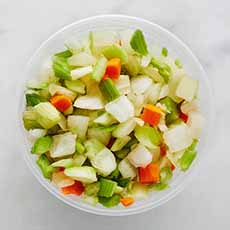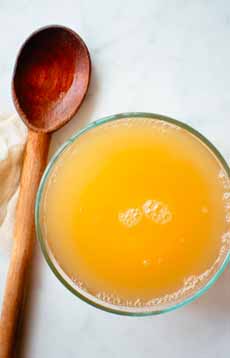TIP OF THE DAY: Dice & Freeze Your Vegetables For A Mirepoix
|
|
Why are meal delivery kits so popular? One reason is that all the ingredients come chopped, measured and ready to cook. People who want to prepare their own dinners save the time and mess of prepping. On the other end are people who make their own stocks. They typically freeze raw vegetable ends along with bones for making stocks and broths. Here’s a third approach: The next time you’re slicing carrots and celery, onions, bell peppers and other vegetables for one recipe, chop up double or triple the amount and freeze the extra for the next recipe(s). Just a mini-tip for freezing: Use a heavy-duty plastic freezer bag. In French cuisine, many recipes begin with a mirepoix (MEER-uh-pwah), also known as aromatics: a combination of chopped carrots*, celery and onions. Professional chefs refer to it as “The Holy Trinity.” These vegetables, along with optional ingredients like garlic, herbs, spices and additional vegetables are cooked butter or are added raw or cooked—roasted or sautéed—to sauces, soups, stews and stocks. In non-butter-based cuisines like Mediterranean cuisines, olive oil is the cooking medium. Cooking the aromatics helps to release their flavors and aromas, creating a deep flavor foundation for the recipe that follows. Recipes will tell you how much to use; but if you’re free-styling, the classic mirepoix ratio is 2:1:1 ratio of onions, carrots, and celery. How large should your dice be? It depends on the cooking time. The smaller the dice, the faster they cook. Though the browning of aromatics as a base likely dates back considerably, the word mirepoix comes from 18th century France. The name derives, as do numerous other names of French dishes, from the wealthy employer of the cook credited with establishing and stabilizing it. In this case, it was Charles-Pierre-Gaston François de Lévis, duc de Lévis-Mirepoix (1699–1757), from a lineage that began in the 11th century. The ancestral base, Mirepoix, is a commune in the Ariège department in southwestern France. |
|
|
The duke’s cook was known for the technique, serving numerous dishes à la mirepoix. While historians believe that the aromatic mixture existed long before then, they surmised that he was responsible for naming it after the family and making the preparation popular. As was common nomenclature, the preparation was named for his employer (as were Beef Stroganoff, Charlotte Russe, Soufflé Rothschild, and many more—others named after celebrities). Also as was common, alas, unless he was a celebrity chef, the names of the chefs who created these dishes were rarely identified. The Term “Mirepoix” The term mirepoix did not appear prominently in French culinary texts until the 19th century. We don’t know exactly what a dish à la mirepoix was like in the 18th century. Printed recipes appear as early as 1814; the famed chef Marie-Antoine Carême published one in 1816. There are variations with added ingredients, from garlic, ham or pork belly, even Madeira wine. Combinations in both the French culinary repertoire and other European cuisines may include bell peppers, chiles, ginger, various herbs, leeks, mushrooms, parsnips, shallots and tomatoes, depending on the preferences of regional cuisines. The Spanish sofrito, soffritto in Italian, often contains parsley. In Cajun and Creole cuisine, a mirepoix or (jocularly so-called) “holy trinity” is a combination of onions, celery, and bell peppers. A neighbor on our apartment’s floor cooks with a mirepoix almost every night. The minute we get off the elevator and inhale the heavenly aroma, we want to knock on the door and invite ourself to dinner. It’s just our fantasy; although we have told her how much we enjoy it. *For white stock, parsnips are substituted for carrots to keep the color pale. |
||






